The single layer is only the winding of the effective side of a coil in each stator slot, so its total number of coils is only half of the total number of motor slots. The advantage of a single-layer winding is that it is more convenient to embed the wires, and the utilization of the grooves is high. The disadvantage is that the selection of the pitch is limited, the electromagnetic performance of the motor is not ideal, and it is mostly used in small and medium-sized motors.
Stator windings are divided into two types: apparent polarity and hidden polarity.
(1) Sole-pole winding spans The two pole groups that are in phase with each other in two adjacent pole faces are connected by a "head contact" and a "tail contact tail." In the epipolar winding, each pole group forms a pole, and the number of pole groups per pole is equal to the number of poles. In other words, there are several pole groups in the pole-type winding. The motor is a few pole motor. Figure 5-8 shows a 4-pole polar winding with one phase.
In the epipolar winding, in order to make the polarities of the magnetic poles N and s mutually spaced, the current directions in the adjacent two polar groups are opposite, and the current directions in the effective sides of the two adjacent coils are the same. .
(2) The two-pole phase group of the two-pole phase in the two adjacent non-adjacent pole faces of the hidden-pole (bung) type winding is connected in a “head-to-tail†and “tail-joint†manner. The winding is called a hidden-pole winding. , as shown in Figure 5-9. In the hidden-pole winding, each pole group forms two magnetic poles. The number of pole groups of the windings is half of the number of magnetic poles, and the other half of the magnetic poles are formed by the magnetic flux generated by the pole groups. In other words, the number of poles in a motor with a hidden pole winding is twice the number of pole groups in each phase.
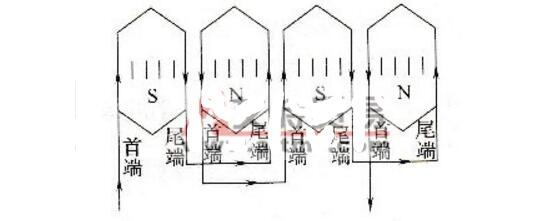
Figure 5-8 Leaded winding 
Figure 5-9 Hidden winding
In a hidden-pole winding, the polarities of the poles formed by each pole group are the same, and the current directions of all pole groups are the same.
Hidden pole windings are mostly used in older models and are now obsolete. Modern electric motors are only used in two-speed motor windings. There is only one set of stator windings for two-speed motors. The method of inserting wires is the same as that of single-speed motors. The difference is that the number of poles (ie changing the apparent and hidden poles) is reached. The purpose of the shift.
Three-phase single-layer windingAccording to the different winding shapes, single-layer windings are divided into three types: chain, concentric and crossover.
(1) Chain-type windings Chain-type windings consist of single-layer coil elements with the same shape and the same pitch, and are named after the coils at the ends of the windings as a set of rings. Figure 5-10 shows three Phase 24 slot 4 pole monolayer chain winding pitch.
Single-layer chain windings have equal pitch and are more convenient for winding. When the chain-type arrangement is used, the end portions of the windings cross more, and the end-shaping is more difficult.
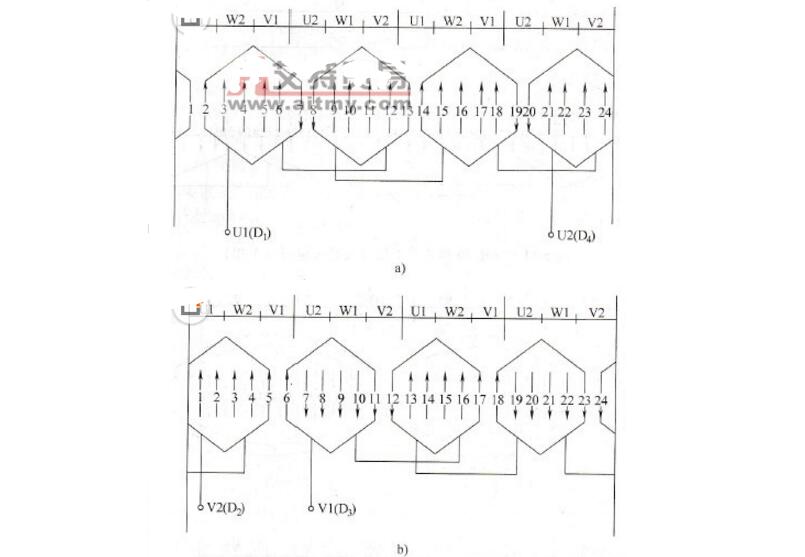
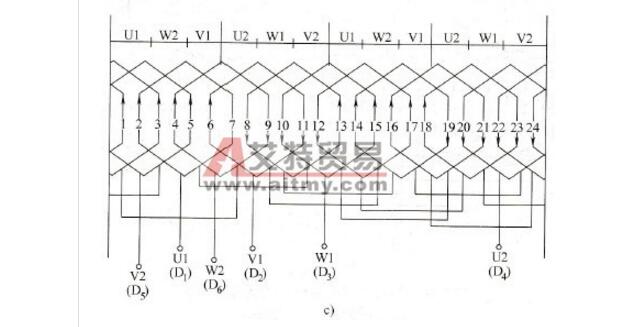
Figure 5-10 Three-phase 24-slot 4-pole single-layer chain winding pitch
â–³Note: The coil pitch of single-layer chained winding must be odd, otherwise the winding will not be arranged.
(2) Cross-winding The cross-winding is composed of winding elements of two different pitches arranged one by one, with the characteristics that the winding of the components is not as convenient as the chain, but short-pitch windings can be used. Helps improve motor performance. Figure 5-11 shows a three-phase 36-slot 4-pole single-layer cross-winding (phase A) development.

Figure 5-11 Three-phase 36-slot 4-pole monolayer cross-linked winding (phase A)
(3) Concentric windings The concentric windings consist of two coils of unequal pitch in the same pole group. It is named because all the coils in the polar group embrace the same center of circle. The characteristics of concentric windings are that the pitches of components in the same pole group are not equal. When winding, several different sized dies are required. However, several components are placed concentrically, and the ends do not cross each other and are easy to align. Figure 5-12 shows a 24-slot, 2-pole monolayer concentric winding development.
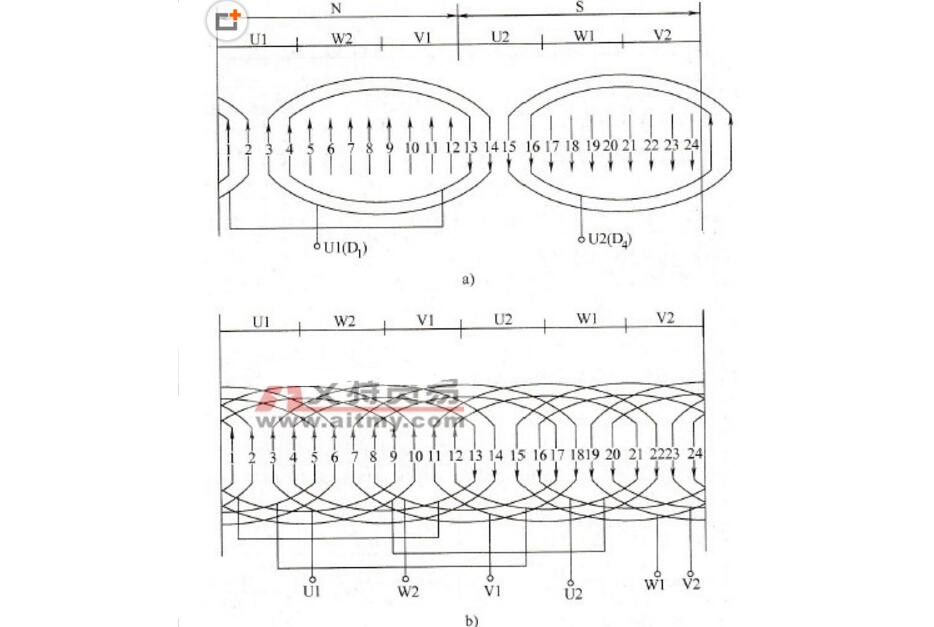
Figure 5-12 Unfolding diagram of a 24-slot, two-pole, single-layer concentric winding a) Phase A winding b) Three-phase winding
Three-phase single-layer winding end connection performance and characteristics1, equal width (stacked)
The coils are equidistant, all coils have the same pitch, and line dies are easy to adjust; coil pitches are shorter than polar distances (full-distance) and are less wire rods; single-layer windings have fewer coils and time is ruled, but electrical performance is poor .
2, concentric
The windings are single-layered and have a high slot fill rate. The average value of the coil pitch is equidistant. The winding ends have a large length and consume wire, and the magnetic leakage is large and the electrical performance is also poor; The wire forms a "double-plane" or "tri-planar" winding, making the ruled wire convenient and suitable for use in two-pole motors.
3, cross type
The winding is a full pitch, but the average pitch of the coils is shorter, and the use of wires is more economical; the number of coils and the pitch of each group are not equal, adding difficulty to the embedding process; the tank full rate is high and the electrical performance is poor. In addition, the end connection can also be a concentric crossover, that is, changing the two coils of equal width into concentric ones.
4. Three-phase single-layer 4-pole 36-slot winding end connection
It can be seen from the three-phase four-pole 36 slots that the number of slots per phase of the winding q=3. There are three possible ways to connect the ends, which are depicted in (a), (b), (c), and only one of them is connected. phase.
(a) Constant width (chain type)

(b) Concentric
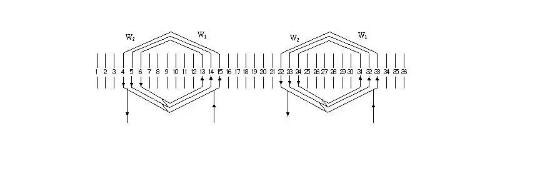
(c) Crossover

In practice, which kind of end connection method is chosen is not considered by the repair staff. Only the designer considers it. For repair personnel, under normal circumstances, the original design data is an important basis for rewinding the motor and cannot be changed.
5, three-phase single-layer 4-pole 24-slot winding end connection
From the basic parameters of three-phase four-pole and twenty-four slots, the number of slots per pole can be calculated as two. According to the rules, there are three types of end connections, as shown in the figure below.
(a) Constant width (stacked)

(b) Concentric

(c) Single-chain

In short, the above types of single-layer windings have the advantages of high slot utilization rate, less occurrence of phase-to-phase short circuits, fewer coils, and reduced man-hours, and are widely used in small motors. In commonly used Y series motors, single stack windings are used for q=2 4, 6, and 8 pole motors; single layer cross windings are used for q=3 2,4 pole motors; concentric windings are used for q=4 2-pole motor. These winding patterns are often seen in daily repair work. In addition, due to the limitation of the structure of single-layer windings, the winding ends are thick and difficult to be shaped, and the short-distance can not be used to improve the electromagnetic performance of the windings. This is the reason that the single-layer winding motor performance is poor.
12V Storage Battery,12V25Ah Ups Gel Battery,Solar Energy Storage Batteries,12V Storage Solar Battery
Jiangsu Stark New Energy Co.,Ltd , https://www.stark-newenergy.com